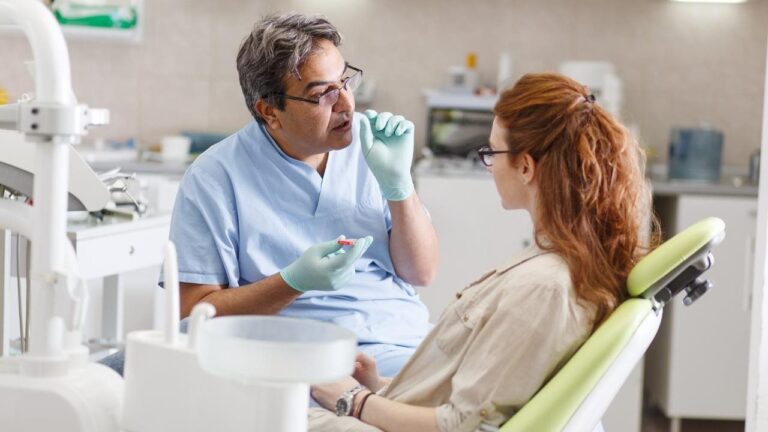(BPT) – Gum disease. Almost half of US adults over the age of 30 (or nearly 65 million people) have it1. However, only 16% of adults 30+ (referred to as “consumers”) report being diagnosed, according to a new national study by OraPharma conducted by The Harris Poll – meaning millions of Americans may have the condition for life without realizing it.
Additionally, the same survey revealed that 91% of consumers mistakenly believed or were unsure whether gingivitis is curable, when in fact, gum disease is not curable, but only managed through ongoing monitoring and treatment as needed. With gum disease, more frequent visits to the dentist may be required because it is a chronic, lifelong bacterial infection.
Given the misconceptions surrounding gum disease, recognizing its symptoms and learning how it can be treated is key to having informed conversations with a dentist or hygienist.
Here’s an overview of the key findings from the research and how consumers can (and should) leverage these insights to close the oral hygiene awareness gap.
Know the signs
Understanding the signs of gum disease is a critical first step in preventing the potentially serious consequences that can result from it, such as damage to the soft tissue and bone that supports the teeth, and even tooth loss. Gingivitis may be associated with an increased risk for other chronic conditions throughout the body, such as cardiovascular disease.
Recent research has revealed that around a third of consumers (33%) do not know all the symptoms of gingivitis. In fact, 92% of dentists agreed that they would like their patients to come to them sooner when they experience symptoms of gingivitis. If you notice any of the following symptoms, it’s important to talk to a dentist or hygienist.
Have the right conversations
The research also revealed a disconnect between gum health conversations reported by dentists and hygienists and those reported by consumers during appointments. Example: While a staggering 90% of dentists and hygienists report discussing gum health during at least half of their dental appointments, only 62% of consumers who visit the dentist say the same.
These research findings reveal that both consumers and dentists/hygienists can benefit from improved conversations during dental appointments. However, getting the conversation right can be difficult, especially when you don’t know what questions to ask. To help with this, OraPharma has developed a dentist discussion guide to help consumers navigate the discussion at their next dental appointment.
I’m going to you aboutgumdisease.com and download a gum health discussion guide designed to help consumers understand exactly what to discuss with their dental care providers to protect their gum health.
bibliographical references
1. Eke PI, Dye BA, Wei L, Thornton-Evans GO, Genco RJ. Periodontitis Prevalence in Adults in the United States: 2009 and 2010. Journal of Dental Research. 2012? 91 (10): 914-920. doi: 10.1177/0022034512457373
ORA.0076.USA.24
Method Statement for Consumer Research
The survey was conducted online in the United States by The Harris Poll on behalf of OraPharma among 1,004 US adults aged 30+ (“consumers”). The survey was conducted February 13-26, 2024.
Data are weighted, where appropriate, by age, race/ethnicity, region, education, marital status, household size, employment, household income, and political party affiliation to align with their actual proportions in the population.
Respondents for this survey were selected from among those who agreed to participate in our surveys. The sampling precision of Harris online polls is measured using a Bayesian confidence interval. For this study, the sample data is accurate to within + 3.7 percentage points using a 95% confidence level. This credible interval will be wider among subsets of the respondent population of interest.
All sample surveys and polls, whether they use probability sampling or not, are subject to multiple other sources of error that most often cannot be quantified or estimated, including but not limited to coverage error, nonresponse error, of error associated with question and answer wording choices, as well as weighting and post-survey adjustments.
Method Statement for Dental Health Provider Research
The survey was conducted online in the United States by The Harris Poll on behalf of OraPharma among 404 Dental Healthcare Professionals (“DHCPs”), including 201 Dentists (non-specialty or periodontist) and 203 practicing dentists, aged 18+. in the US, are licensed in the state where they practice, have practiced for at least 1 year, do not see primarily pediatric patients, and see at least 5 patients with periodontal disease per week. The survey was conducted February 13-27, 2024.
Data for both dentists and female dentists are weighted, where appropriate, by sex, to align with their actual proportions in the population. Data for dentists and dentists were then combined using a position weight proportional to population size to create a set for DHCP.
Respondents for this survey were selected from among those who agreed to participate in our surveys. The sampling precision of Harris online polls is measured using a Bayesian confidence interval. For this study, the sample data are accurate to + 5.5 percentage points using a 95% confidence level. This credible interval will be wider among subsets of the respondent population of interest.
All sample surveys and polls, whether they use probability sampling or not, are subject to multiple other sources of error that most often cannot be quantified or estimated, including but not limited to coverage error, nonresponse error, of error associated with question and answer wording choices, as well as weighting and post-survey adjustments.
®/™ are trademarks of Bausch Health Companies Inc. or its subsidiaries. ©2024 Bausch Health Companies Inc. or its subsidiaries.


